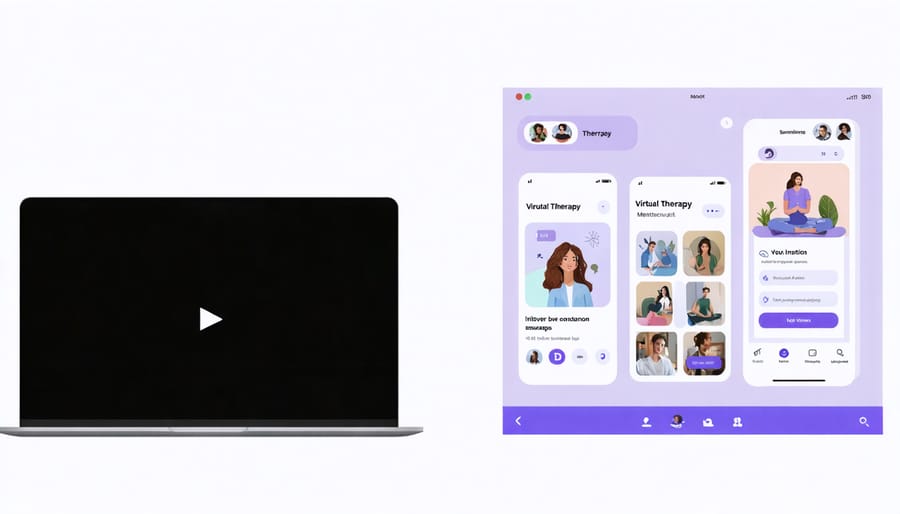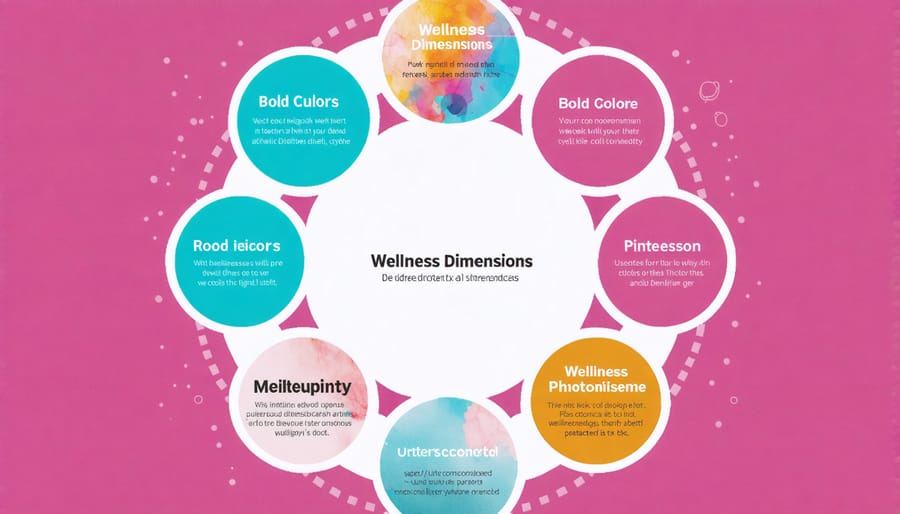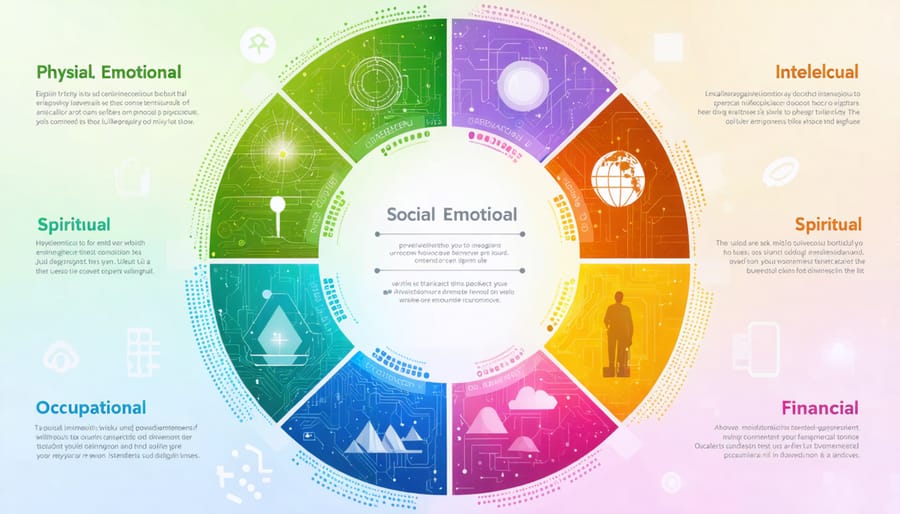Transform your wellbeing today by embracing the nine interconnected dimensions of wellness – physical, emotional, intellectual, social, spiritual, environmental, occupational, financial, and digital. While traditional wellness models focused primarily on physical health, modern research reveals how these distinct yet harmonious elements create a complete picture of human thriving. Using digital health tools and evidence-based strategies, Canadians can now track, enhance, and balance each dimension for optimal health outcomes.
Recent studies show that individuals who actively nurture all nine wellness dimensions report 60% higher life satisfaction and demonstrate greater resilience against both physical and mental health challenges. Whether you’re looking to boost your career satisfaction, deepen your relationships, or improve your physical vitality, understanding these interconnected aspects of wellness provides a comprehensive framework for lasting positive change.
This guide explores each dimension in detail, offering practical strategies to help you create a more balanced, fulfilling life in our increasingly digital world. Learn how small, intentional adjustments across these nine areas can lead to transformative improvements in your overall quality of life.
Physical Wellness in the Digital Age
Digital Fitness Solutions
In today’s digital age, technology has become an invaluable ally in our wellness journey. Fitness apps and wearable devices offer personalized tracking of physical activity, heart rate, and sleep monitoring, helping Canadians make informed decisions about their health. Popular platforms like Strava, MyFitnessPal, and Nike Training Club provide structured workout plans, nutrition guidance, and community support.
Smart watches and fitness trackers have evolved beyond simple step counting, now offering features like stress detection, guided breathing exercises, and workout intensity recommendations. Virtual training platforms have made expert-led workouts accessible from home, particularly valuable during Canadian winters or when gym access is limited.
These digital solutions also promote accountability through goal-setting features, progress tracking, and social connectivity. However, it’s important to choose tools that align with your personal wellness goals and comfort level with technology. Start with one or two apps that address your primary health objectives, and gradually incorporate additional tools as needed.

Screen Time and Physical Health
In today’s digital age, many Canadians spend significant time in front of screens, which can impact physical health in various ways. Extended periods of sitting and poor posture while using devices can lead to muscle tension, eye strain, and reduced physical activity levels. To maintain wellness while using technology, it’s important to practice proper ergonomics by keeping screens at eye level, maintaining good posture, and using supportive chairs.
Taking regular movement breaks every 30-60 minutes can help counteract the effects of prolonged sitting. Simple activities like stretching, walking, or doing quick exercises can make a significant difference. Using the 20-20-20 rule (looking at something 20 feet away for 20 seconds every 20 minutes) can help reduce digital eye strain.
Consider using standing desks or active workstations when possible, and try to limit recreational screen time to no more than 2 hours per day outside of work requirements. Evening screen time should be minimized, as blue light exposure can affect sleep quality. Using night mode settings and keeping devices away from the bedroom can help maintain healthy sleep patterns while still enjoying the benefits of technology.
Emotional and Mental Wellness Online
Digital Mental Health Resources
In today’s digital age, numerous online resources make mental health support more accessible than ever. Popular apps like Headspace and Calm offer guided meditation and mindfulness exercises, helping Canadians maintain their mind-body wellness through daily practice. Online therapy platforms such as BetterHelp and TalkSpace connect users with licensed mental health professionals, offering flexible scheduling and secure video sessions.
Mental wellness apps like Moodfit and Sanvello provide mood tracking, cognitive behavioral therapy exercises, and stress management tools. These applications can help you identify patterns in your emotional well-being and develop healthy coping strategies. Many employers and insurance providers now offer access to digital mental health platforms as part of their benefits packages.
For those seeking community support, platforms like 7 Cups and Anxiety Canada’s MindShift app offer peer support groups and evidence-based anxiety management techniques. Remember to choose platforms that are privacy-compliant and ideally recommended by mental health professionals or reputable organizations.

Social Media and Emotional Balance
In today’s digital age, maintaining emotional balance while navigating social media requires mindful attention and strategic boundaries. While these platforms offer valuable ways to stay connected with loved ones, excessive use can impact mental well-being, sleep quality, and overall life satisfaction.
To create a healthier relationship with social media, start by setting specific time limits for platform use. Consider designating “digital-free” periods during meals or before bedtime. Pay attention to how different types of content affect your mood, and curate your feed to prioritize positive, inspiring information that aligns with your wellness goals.
Be mindful of comparison triggers and remember that social media often shows carefully curated highlights rather than complete reality. Practice regular digital detoxes to reset your emotional baseline and strengthen real-world connections. When feeling overwhelmed, try mindfulness techniques like deep breathing or step away from your device to engage in physical activity.
Creating boundaries with notifications and implementing features like “do not disturb” can help maintain emotional equilibrium while still enjoying the benefits of digital connection.
Social and Environmental Wellness
In today’s digital age, our social connections and environmental wellness are increasingly influenced by technology. While online platforms have transformed how we build and maintain relationships, it’s essential to strike a balance between virtual and face-to-face interactions. Digital communities can provide valuable support, especially for those with limited mobility or in remote areas, offering connections with like-minded individuals who share similar health goals and interests.
Technology also plays a crucial role in environmental awareness and action. Apps and online platforms help us track our carbon footprint, find sustainable products, and connect with local environmental initiatives. Smart home devices can optimize energy usage, while digital tools enable paperless solutions and reduce waste. Many Canadians are using technology to participate in citizen science projects, contributing to environmental research and conservation efforts from their smartphones.
However, it’s important to maintain meaningful in-person connections alongside digital interactions. Consider joining local community groups that combine social interaction with environmental action, such as community gardens or cleanup initiatives. Use social media mindfully to organize real-world meetups and activities that promote both social bonds and environmental stewardship.
To enhance both social and environmental wellness, try using technology to:
– Connect with local environmental groups
– Share sustainable living tips with your network
– Track and reduce household energy consumption
– Organize community events and activities
– Support and encourage others in their wellness journey
– Learn about and participate in local conservation efforts
Occupational and Financial Wellness
In today’s digital age, managing your career and finances has become more accessible through various online tools and applications. Career development platforms like LinkedIn Learning, Coursera, and other professional development sites offer opportunities to enhance your skills and stay competitive in the job market. These digital resources allow you to learn at your own pace while maintaining work-life balance.
Financial wellness apps have revolutionized how we handle money, making budgeting and saving more manageable. Tools like Mint, YNAB (You Need A Budget), and banking apps help track expenses, set financial goals, and monitor spending patterns. Many Canadian banks now offer comprehensive digital solutions that include investment tracking, retirement planning, and automated savings features.
Smart career management includes using job search platforms, professional networking sites, and virtual mentoring programs. These tools can help you identify growth opportunities, connect with industry peers, and stay informed about market trends. Additionally, remote work platforms and project management tools enable flexible work arrangements that can improve work satisfaction and reduce stress.
For financial education, numerous online resources provide free courses on topics like investing, debt management, and retirement planning. Government websites offer reliable information about taxes, benefits, and financial programs available to Canadians. Digital tools can also help track workplace benefits, manage insurance policies, and organize important financial documents.
Remember to maintain healthy boundaries with work-related technology and regularly review your financial tools to ensure they continue to serve your needs effectively. The key is finding a balance between utilizing digital resources for career and financial growth while preventing technology overuse or dependency.

Intellectual and Creative Wellness
In today’s digital age, nurturing intellectual and creative wellness has become more accessible than ever through online learning platforms and digital creativity tools. These resources provide unprecedented opportunities for personal growth, skill development, and creative expression from the comfort of your home.
Popular learning platforms like Coursera, LinkedIn Learning, and edX offer courses spanning various subjects, from professional development to personal interests. These platforms allow you to learn at your own pace while connecting with learners worldwide, fostering both intellectual growth and social interaction.
Digital creativity tools have revolutionized how we express ourselves artistically. Applications like Canva for graphic design, GarageBand for music creation, and digital painting software enable anyone to explore their creative potential without traditional barriers to entry. These tools not only facilitate creative expression but also help develop problem-solving skills and boost cognitive function.
To maintain intellectual and creative wellness in the digital space:
– Set aside dedicated time for learning new skills
– Engage in brain-training apps and puzzles
– Join online creative communities to share work and receive feedback
– Take virtual museum tours and attend digital art exhibitions
– Participate in online writing workshops or creative challenges
– Use mindfulness apps to enhance focus and creative thinking
Remember to balance screen time with offline activities. Combine digital learning with practical application, such as trying new recipes after an online cooking course or practicing meditation techniques learned through wellness apps. This integrated approach ensures that your intellectual and creative growth remains both engaging and sustainable.
Spiritual and Cultural Wellness
In today’s digital age, nurturing your spiritual and cultural wellness doesn’t require visiting a physical temple or cultural center. Many digital platforms now offer meaningful ways to explore and deepen your spiritual practice while staying connected to your cultural roots.
Popular meditation apps like Insight Timer and Calm provide guided spiritual practices, mindfulness exercises, and teachings from various religious and philosophical traditions. These resources can help you develop a consistent spiritual practice that fits your schedule and beliefs.
For cultural connection, virtual museum tours allow you to explore art, artifacts, and historical exhibits from around the world. Many Canadian museums, including the Royal Ontario Museum and the Canadian Museum of History, offer immersive online experiences that celebrate diverse cultural heritage.
Social media platforms and online communities can help you connect with others who share your cultural background or spiritual interests. Join virtual cultural celebrations, participate in online religious services, or engage in discussion groups about spiritual topics that matter to you.
Digital learning platforms offer courses on world religions, cultural studies, and spiritual practices. These resources can help you better understand different belief systems and cultural perspectives, fostering personal growth and cultural competency.
Remember to maintain a balance between digital and real-world spiritual experiences. While technology can enhance your spiritual and cultural journey, consider complementing online activities with in-person community gatherings, cultural events, and spiritual practices when possible.
Set aside dedicated time for digital spiritual practices, free from distractions. Create a peaceful space in your home where you can engage with these resources mindfully and meaningfully.

Creating Your Digital Wellness Plan
Assessment Tools
Several digital tools can help you assess and track your progress across the nine wellness dimensions. Popular wellness apps like MyFitnessPal and Headspace offer specialized tracking for physical and emotional wellness. Smart watches and fitness trackers monitor sleep patterns, physical activity, and stress levels through heart rate variability. Many mental health apps provide mood tracking and meditation progress monitoring.
For social and occupational wellness, time-management apps can track work-life balance and social interactions. Financial wellness apps help monitor spending habits and savings goals. Digital journals and gratitude apps support spiritual and emotional wellness tracking. Environmental wellness can be monitored through air quality apps and sustainable living trackers.
Remember to choose tools that feel manageable and meaningful to you, as overwhelming yourself with too many tracking methods can be counterproductive to your wellness journey.
Balance Strategies
Set clear boundaries with your digital devices by establishing tech-free zones and designated offline times. Consider implementing a “digital sunset” one hour before bedtime and keeping devices out of the bedroom. Creating a schedule for checking emails and social media can help in maintaining healthy balance between online and offline activities. Use apps that track screen time and set daily limits for social media usage. Practice mindful technology use by turning off non-essential notifications and dedicating specific times for focused work without digital interruptions. Regular digital detoxes, even if just for a few hours each week, can help reset your relationship with technology and improve overall wellness.
Understanding and nurturing all nine dimensions of wellness is essential for achieving a truly balanced and fulfilling life. By recognizing how these dimensions – physical, emotional, intellectual, social, spiritual, environmental, financial, occupational, and digital – interact and influence each other, you can create a more holistic approach to your well-being.
Remember that wellness is not a destination but a continuous journey of growth and adaptation. Small, consistent steps in each dimension can lead to significant improvements in your overall quality of life. Start by assessing where you currently stand in each dimension and identify areas that need more attention.
Consider setting realistic goals for each dimension and tracking your progress over time. You might begin with simple actions like taking daily walks for physical wellness, practicing mindfulness for emotional balance, or creating a monthly budget for financial health. The key is to make sustainable changes that align with your personal values and lifestyle.
Don’t feel pressured to perfect all dimensions at once. Instead, focus on gradual improvement and celebrate small victories along the way. Reach out to healthcare providers, wellness coaches, or community resources when you need support or guidance.
By taking action today to enhance these nine dimensions of wellness, you’re investing in a healthier, more balanced future. Your journey to optimal wellness begins with a single step – choose one dimension to focus on and start making positive changes now.

